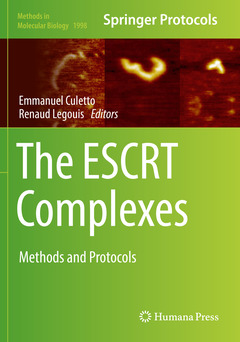Description
The ESCRT Complexes, 1st ed. 2019
Methods and Protocols
Methods in Molecular Biology Series, Vol. 1998
Language: English
Subject for The ESCRT Complexes:
Publication date: 08-2020
Support: Print on demand
Publication date: 07-2019
322 p. · 17.8x25.4 cm · Hardback
Description
/li>Contents
/li>Comment
/li>
1. Analysis of the Archaeal ESCRT Apparatus
Rachel Y. Samson, Iain G. Duggin, and Stephen D. Bell
2. Genetic and Cell Biology Methods to Study ESCRTs in Drosophila melanogaster
Marco Gualtieri and Thomas Vaccari
3. Functional Analysis of ESCRT-Positive Extracellular Vesicles in the Drosophila Wing Imaginal Disc
Tamas Matusek, Pascal Thérond, and Maximilian Fürthauer
4. Subcellular Localization of ESCRT-II in the Nematode C. elegans by Correlative-Light Electron Microscopy
Céline Largeau, Emmanuel Culetto, and Renaud Legouis
5. Proximity Ligation Assay (PLA) to Determine the Endosomal Localization of ESCRT Subunit in Virus-Infected Cells
Binod Kumar, Mohanan Valiya Veettil, Arunava Roy, and Bala Chandran
6. Immuno-Localization of ESCRT Proteins in Virus-Infected Cells by Fluorescence and Electron Microscopy
Keisuke Tabata, Atsuki Nara, Hiroko Omori, and Eiji Morita
7. Single Cell Fluorescence Ratio Image Analysis for Studying ESCRT Function in Receptor Trafficking
Jalal M. Kazan, Gergely L. Lukacs, Pirjo M. Apaja, and Arnim Pause
8. Genetic and Biochemical Analyses of Yeast ESCRT
Sudeep Banjade, Shaogeng Tang, and Scott D. Emr
9. Live Imaging of ESCRT Proteins in Microfluidically-Isolated Hippocampal Axons
Veronica Birdsall, Jose C. Martinez, Lisa Randolph, Ulrich Hengst, and Clarissa L. Waites
10. Studying the Spatial Organization of ESCRTs in Cytokinetic Abscission Using the High Resolution Imaging Techniques SIM and Cryo-SXT
Shai Adar-Levor, Inna Goliand, Michael Elbaum, and Natalie Elia
11. Three Dimensional Surface Rendering of ESCRT Proteins Microscopy Data Using UCSF Chimera Software
Romain Le Bars, Michele W. Bianchi, and Christophe Lefebvre
12. Transient Expression of ESCRT-Components in Arabidopsis Root Cell Suspension Culture-Derived Protoplasts
Marie-Kristin Nagel, Karin Vogel, and Erika Isono
13. Crystallization and Biophysical Approaches for Studying the Interactions between the Vps4-MIT Domain and ESCRT-III Proteins
Takayuki Obita, Rieko Kojima, and Mineyuki Mizuguchi
14. Biochemical Approaches to Studying C. elegans ESCRT Function In Vitro
Samuel Block, Amber L. Schuh, and Anjon Audhya
15. Purification of Recombinant ESCRT-III Proteins and Their Use in Atomic Force Microscopy and In Vitro Binding and Phosphorylation Assays
Luisa Capalbo, Ioanna Mela, Maria Alba Abad, A. Arockia Jeyaprakash, J. Michael Edwardson, and Pier Paolo D’Avino
16. Assessment of ESCRT Protein CHMP5 Activity on Client Protein Ubiquitination by Immunoprecipitation and Western Blotting
Francheska Son, Katharine Umphred-Wilson, Jae-Hyuck Shim, and Stanley Adoro
17. Purification of Plant ESCRT Proteins for Polyclonal Antibody Production
Julio Paez-Valencia and Marisa S. Otegui
18. Genetic and Cytological Methods to Study ESCRT Cell Cycle Function in Fission Yeast
Imane M. Rezig, Shaun K. Bremner, Musab S. Bhutta, Ian P. Salt, Gwyn W. Gould, and Christopher J. McInerny
19. ESCRT Mutant Analysis and Imaging of ESCRT Components in the Model Fungus Ustilago maydis
Carl Haag, Thomas Klein, and Michael Feldbrügge
20. Genetic Suppressor Screen Using an Inducible FREE1-RNAi Line to Detect ESCRT Genetic Interactors in Arabidopsisthaliana
Qiong Zhao, Ying Zhu, Wenhan Cao, Jinbo Shen, Yong Cui, Shuxian Huang, and Liwen Jiang
21. Screening of Interactions with the ESCRT Machinery by a Gaussia princeps Split Luciferase-Based Complementation Assay
Rina Barouch-Bentov, Yves Jacob, and Shirit Einav
22. RNA Interference-Mediated Inhibition of ESCRT in Mammalian Cells
Katherine Bowers
Includes cutting-edge techniques
Provides step-by-step detail essential for reproducible results
Contains key implementation advice from the experts
These books may interest you

Plant EndosomesMethods and Protocols 179.34 €



